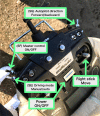Development of a high-throughput field phenotyping rover optimized for size-limited breeding fields as open-source hardware
- PMID: 36045888
- PMCID: PMC8987849
- DOI: 10.1270/jsbbs.21059
Development of a high-throughput field phenotyping rover optimized for size-limited breeding fields as open-source hardware
Abstract
Phenotyping is a critical process in plant breeding, especially when there is an increasing demand for streamlining a selection process in a breeding program. Since manual phenotyping has limited efficiency, high-throughput phenotyping methods are recently popularized owing to progress in sensor and image processing technologies. However, in a size-limited breeding field, which is common in Japan and other Asian countries, it is challenging to introduce large machinery in the field or fly unmanned aerial vehicles over the field. In this study, we developed a ground-based high-throughput field phenotyping rover that could be easily introduced to a field regardless of the scale and location of the field even without special facilities. We also made the field rover open-source hardware, making its system available to public for easy modification, so that anyone can build one for their own use at a low cost. The trial run of the field rover revealed that it allowed the collection of detailed remote-sensing images of plants and quantitative analyses based on the images. The results suggest that the field rover developed in this study could allow efficient phenotyping of plants especially in a small breeding field.
Keywords: field phenotyping rover; high-throughput phenotyping; image processing; open-source hardware; proximal sensing.
Copyright © 2022 by JAPANESE SOCIETY OF BREEDING.
Figures








References
-
- Araus, J.L. and Cairns J.E. (2014) Field high-throughput phenotyping: the new crop breeding frontier. Trends Plant Sci 19: 52–61. - PubMed
-
- Bonnard, Q., S. Lemaignan, G. Zufferey, A. Mazzei, S. Cuendet, N. Li, A. Özgür and P. Dillenbourg (2013) Chilitags 2: Robust fiducial markers for augmented reality and robotics. Chili, Epfl, Switzerland.
-
- David, E., Madec S., Sadeghi-Tehran P., Aasen H., Zheng B., Liu S., Kirchgessner N., Ishikawa G., Nagasawa K., Badhon M.A.et al. (2020) Global wheat head detection (GWHD) dataset: A large and diverse dataset of high-resolution RGB-labelled images to develop and benchmark wheat head detection methods. Plant Phenomics 2020: 3521852. - PMC - PubMed

